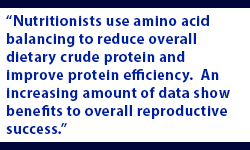
Nutrition and reproductive success
 By Barry Visser
By Barry Visser
Reproductive success is a major component of economic success in dairy herds. Most herds have noticed significant improvement in reproductive performance the past decade. Today, some herds are approaching 40% pregnancy rate. Credit is due to the sophistication of breeding programs, real-time heat detection tools, and emphasis on fertility traits in genetic selection programs, such as daughter pregnancy rate and sire conception rate. We continue to see improvements in cow comfort, heat abatement, and forage and feed bunk management.
Nutrition also plays a major role in reproductive efficiency in dairy cattle. The feeding program throughout all production stages is important for optimizing a herd’s reproductive efficiency. Dry matter intake begins to drop seven to 10 days pre-calving. Feeding practices today aim to minimize the pre-calving DMI drop to diminish the extent and magnitude of negative energy balance. Stable DMI intake before and high DMI after calving usually minimize post-calving metabolic problems and the magnitude of negative energy balance.
Negative energy balance
One of the consequences of metabolic diseases is that cows have reduced appetite and often lose more bodyweight. The goal is for cows to have a body condition score (BCS) of no greater than 3.5 during the dry period and to lose less than 1 BCS during early lactation. Cornell University data revealed that the first ovulation after calving typically occurs about 10 to 14 days after energy balance is at its most negative point. The point when a cow starts her upward swing sets the timing for subsequent ovulations.
In addition, the follicle that will ovulate near the first insemination began development shortly before or just after calving. The follicle takes about 10 weeks to develop according to Dr. Jose Santos, University of Florida reproductive specialist. Thus, follicles ovulating near the time of first breeding were likely developing during the time of negative energy balance. The extent and magnitude of the negative energy balance may affect the fertility of the ovum released.
Protein
Relative to reproduction, the goal for feeding protein has been to not feed it in excess, especially not excessive amounts of rumen degradable protein. Milk and blood urea nitrogen (MUN and BUN, respectively) are monitored accordingly. According to Dr. Mike Hutjens, University of Illinois, the actual targets for MUN are 8 to 12 mg per dL with the aim at reducing feed costs and nitrogen excretion by animals. In addition to environmental benefits, reducing excess nitrogen reduces energy demand on the cow because the process to excrete nitrogen requires energy.
High circulating concentrations of ammonia and urea may be toxic to sperm, ova, or embryos, or may reduce the binding of luteinizing hormone to ovarian receptors, which leads to a decrease in serum progesterone. In general, the focus has been the potential for embryo mortality with high BUN, which is reflected in higher MUN.
 Nutritionists use amino acid balancing to reduce overall dietary crude protein and improve protein efficiency. An increasing amount of data shows benefits to overall reproductive success. Maintenance of pregnancy is obviously as important as conception rates. In addition to reducing BUN, University of Wisconsin research showed lactating dairy cows supplemented with a protected methionine source saw reduced incidences of early embryonic loss. Researchers are currently re-evaluating cows’ protein and amino acid requirements in early lactation during negative energy balance.
Nutritionists use amino acid balancing to reduce overall dietary crude protein and improve protein efficiency. An increasing amount of data shows benefits to overall reproductive success. Maintenance of pregnancy is obviously as important as conception rates. In addition to reducing BUN, University of Wisconsin research showed lactating dairy cows supplemented with a protected methionine source saw reduced incidences of early embryonic loss. Researchers are currently re-evaluating cows’ protein and amino acid requirements in early lactation during negative energy balance.
Minerals and vitamins
Minerals (macro and trace minerals) and vitamins (A, D, E) are all critical to metabolic functions related to reproduction. While these nutrients are always important for production, health, and reproductive performance, mineral and vitamin availability is particularly critical during the period between freshening and rebreeding. Use of highly available sources (maximizing absorption) is helpful to ensure status in the animal and prevent over-formulation that can create other problems, including antagonisms of one mineral due to high levels of another.
Fatty acids
Although still an area requiring considerable research, numerous trials have shown a response to the correct balance of essential fatty acids. Protected forms of omega-3 and omega-6 fats may be beneficial to reproduction.
Nutrition for your herd
Nutrition related to reproductive efficiency is a delicate balance. Energy and protein are the major nutrients and should be in the topmost priority to optimize reproduction in dairy cattle. Minerals and vitamins must be balanced in the diet. On the other hand, nutrients should not be over-fed as this may also impair reproduction. Work with your nutritionist to ensure your cows receive a balanced diet designed to maximize reproductive performance and herd profitability.
This article was originally written for the January 30, 2021, issue of Dairy Star.
About the author: Barry Visser is a dairy technical specialist based in Minnesota. He grew up on his family’s dairy farm in northwest Minnesota. Visser received his bachelor’s degree in animal science from the University of Minnesota in 1994. He worked as a dairy nutritionist for four years before returning to graduate school to earn his master’s degree in dairy cattle nutrition. His research focused primarily on transition cows and minimizing pre- and post-calving metabolic challenges. While a graduate student, Visser also worked as an assistant herdsman for the University of Minneosta St. Paul dairy herd. At Vita Plus, Visser works with fellow employee owners to troubleshoot farm nutrition, forage quality and management challenges.
| Category: |
Animal health Dairy Performance Feed additives Feed quality and nutrition Transition and reproduction |

